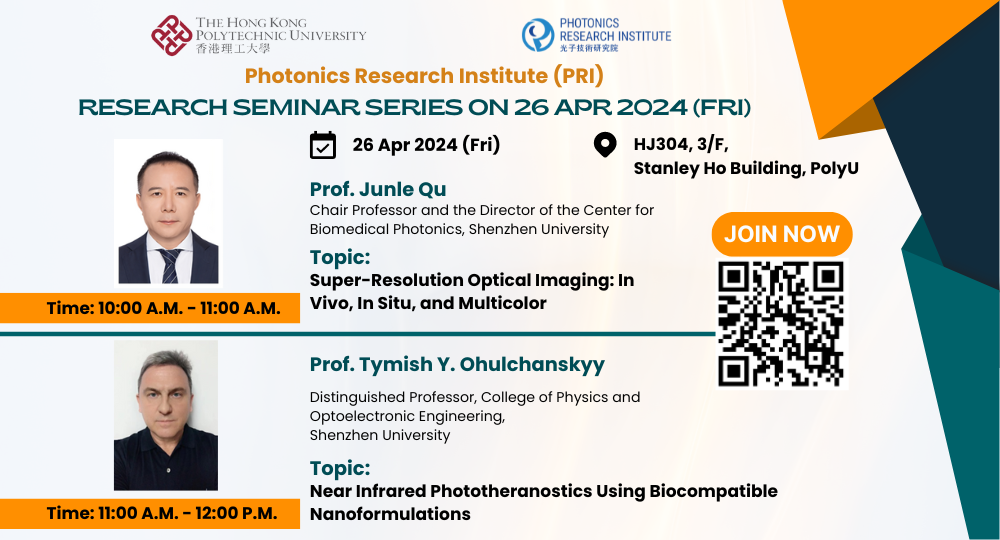PRI Research Seminar Series on 26 Apr 2024 (Fri)
Conference / Lecture

-
Date
26 Apr 2024
-
Organiser
Photonics Research Institute (PRI)
-
Time
10:00 - 12:00
-
Venue
HJ304, 3/F, Stanley Ho Building, PolyU
Summary
Speaker:
Prof. Junle Qu
Chair Professor and the Director of the Center for Biomedical Photonics, Shenzhen University
Topic
Super-Resolution Optical Imaging: In Vivo, In Situ, and Multicolor
Abstract
Super-resolution imaging and fluorescence lifetime imaging microscopy (FLIM) are two important microscopy techniques. Combining these two techniques to achieve super-resolution fluorescence lifetime imaging is generally inefficient and can even be contradictory in terms of data acquisition and signal processing. With advances in time-resolved detection and computational imaging, a fluorescence spatiotemporal modulation strategy based on phase analysis has been proposed. This strategy combines time-domain electronics and phase analysis methods and can extract detailed and accurate photon information from both time and space dimensions. Using only a single-pulse laser as light source, multicolor super-resolution imaging of living cells was achieved. Furthermore, by developing new optical methods and new probes, the light power required for stimulated emission depletion (STED) super-resolution imaging has been significantly reduced, improving imaging performance and realizing in vivo super-resolution imaging. This talk will introduce the recent progress in super-resolution optical imaging techniques and their applications and provide a perspective on the future development of super-resolution imaging technology.
Biography
Prof. Junle Qu is a Chair Professor and the Director of the Center for Biomedical Photonics at Shenzhen University. He has been honored with the Outstanding Youth Fund award by the National Natural Science Foundation of China and also holds fellowships with the International Society for Optical Engineering (SPIE), Optical Society of America (Optica), and the Chinese Optical Society (COS). Prof. Qu earned his M.S. and Ph.D. from Xi'an Institute of Optics and Precision Mechanics, Chinese Academy of Sciences, in 1995 and 1998, respectively. Between 2001 and 2003, he served as a postdoctoral associate at Indiana University in Bloomington, Indiana, USA. Since July 2003, he has been a faculty member at Shenzhen University’s College of Physics and Optoelectronic Engineering. Prof. Qu's research interests include multimodal nonlinear optical imaging, super-resolution optical imaging, nanobiophotonics technology, and light-induced therapy. His work has been featured in over 600 peer-reviewed scientific articles across eminent journals such as Nature Photonics, Nature Communications, and Advanced Materials. To date, Prof. Qu has been authorized more than 100 invention patents, with 18 patents transferred. Prof. Qu serves as the Director of the Biomedical Photonics Committee of the Chinese Optical Society, an Associate Editor for Biomedical Optics Express, and the Associate Editor-in-Chief of the Journal of Innovative Optical Health Sciences (JIOHS).
Speaker:
Prof. Tymish Y. Ohulchanskyy
Distinguished Professor, College of Physics and Optoelectronic Engineering, Shenzhen University
Topic
Near Infrared Phototheranostics Using Biocompatible Nanoformulations
Abstract
Due to an ability of the ability of near-infrared (NIR) light to penetrated deeper into biological tissue, NIR optical bioimaging is rapidly evolving as a powerful yet feasible biomedical imaging technique, allowing for imaging guided surgery, therapy and drug delivery. While possessing the NIR imaging contrast, NIR light absorbing/emitting nanoformulations can also be garnished with other medical imaging modalities (e.g., computed tomography, CT, and magnetic resonance imaging, MRI), providing a single nanoagent for multiple imaging techniques and enabling the integration of cellular, tissue and whole body imaging. NIR spectral region can also be beneficial for phototherapy (e.g., photodynamic and photothermal therapies, PDT and PTT), allowing for deeper penetration of light to excite phototherapeutic agents and treat diseased tissues. Nanotheranostics that combines PDT and/or PTT with other therapeutic modalities has been shown to result in synergistically enhanced and localized treatment with minimal adverse effects. A systemic toxicity can be further diminished by a development of biocompatible nanoplatforms that produce tumor specific therapeutic action in response to the tumor microenvironment (TME) or external stimuli. This talk will present our recent results on development of heterogeneous photoactive biocompatible nanoformulations for NIR phototheranostics that combines NIR optical imaging and light induced therapy. The developed nanoplatforms include polymeric nanoparticles, nanoliposomes or protein nanocrystals, which are loaded with NIR fluorescent organic dyes and other functional small molecules, including chemotherapeutics and agents for photothermal and photodynamic therapies. The talk will demonstrate examples of applications of nanoparticles as multimodal imaging guided therapeutic agents and conclude with a discussion on the challenges and opportunities in the domain of optically active nanoformulations for NIR imaging guided phototherapies of cancer and other diseases.
Biography
Prof. Tymish Y. Ohulchanskyy holds Ph.D. in optics and laser physics from Taras Shevchenko National University of Kyiv (Ukraine). After receiving Ph.D. in 2001, he joined the University at Buffalo (Buffalo, NY, USA) as a postdoctoral associate in the Institute for Lasers, Photonics and Biophotonics (ILPB), where he later became a principal investigator and the ILPB deputy director. Since 2016, Prof. Ohulchanskyy is a distinguished professor in the College of Physics and Optoelectronic Engineering at Shenzhen University; he is also affiliated with University at Buffalo as a research professor in the Department of Chemical and Biological Engineering. Prof. Ohulchanskyy’s research broadly involves photochemistry and photophysics of organic molecules and organic, inorganic and hybrid nanostructures, applications of optical spectroscopy/microscopy and optical/multimodal imaging in biomedical field as well as various aspects of photobiology. Prof. Ohulchanskyy has published more than 170 peer-reviewed articles that have been cited more than 18000 times (h-index is 60).


